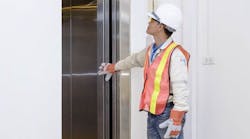How healthy is your elevator? Without regular monitoring, it’s hard to tell until there’s a problem or a complaint.
These three early indicators of elevator problems can be tracked by facilities staff.
Photo: Doors account for more than half of calls for elevator shutdowns; Credit: Shutter Stock
1. Ride Quality
Poor ride quality is often an early sign of an impending elevator problem.
If you receive any complaints from tenants about bumps, noises, or a ride that’s not smooth, it’s time to call a technician, explains Chris Bowler, senior director of global service marketing for Otis.
“[Vibration and noises] are symptoms of potential ride quality issues,” adds Jon Clarine, head of digital services for thyssenkrupp Elevator.
“If you feel it’s not normal, bring it up to the service provider immediately. It could potentially be a safety question and we want to get ahead of those as soon as they’re heard.”
2. Leveling
“When the elevator stops at a floor, do you notice that the floor of the elevator is higher or lower than the landing?” asks Bowler. “If so, you may need a tune-up.”
Poor leveling isn’t just a sign that your elevator needs work—it's a potential liability issue if someone trips over the unlevel surface and gets hurt.
For your occupants’ sake, call in a technician if you notice your elevator isn’t leveling correctly.
3. Doors
Doors cause more than 50% of calls for elevator shutdowns, Bowler explains.
Pay attention to them as they close and open and take note of anything out of the ordinary, such as the door closing and then reopening for no apparent reason.
“That could be a sign that the system is trying to self-correct and causing a problem,” Clarine says.
“Moving parts are what receive the most wear and tear over time,” Clarine adds.
“Doors are opening and closing, people are putting chairs in front of them and jamming them open when they need to move furniture. You have an interface with a small crack where pens, pen caps, debris, car keys, and cell phones get dropped into.
The door system itself is a highly mechanical and fast-moving, highly repeated motion. With that, it requires regular, routine preventive maintenance and is at risk of having issues.”
IoT Tools Enable Earlier Detection
Vertical transportation companies are increasingly using Internet of Things (IoT) sensors to diagnose elevator problems before you even notice them.
IoT platforms like Otis ONE and thyssenkrupp MAX give facilities managers an easy way to look at how their elevators are performing while providing valuable feedback about function for technicians. FMs can gain insights into things like:
-
Uptime. Is your elevator functioning? If not, you can find out ahead of time—preferably before demand to use the elevator is high—and call for repairs.
-
Operating mode. Elevators may periodically be switched out of normal operating mode for inspections or other uses. “If it’s still in fire service mode, it’s not available for normal service, and that’s a problem,” Clarine explains.
-
Predictive data. View which floors are busiest and see when you might need service or upgrades. Data like floor use can help not only with elevator maintenance but with leasing considerations, Clarine says—you can see which floors have the most traffic. “The future of service is a move toward predictive maintenance to address issues before they occur, which means you don’t have to be on the lookout for any issues at all,” adds Bowler.
In the meantime, Bowler recommends using your maintenance contract if you notice anything strange or are receiving complaints.
Elevator technicians are trained to resolve your problem quickly and get your elevator back into service as soon as possible.
“Because almost every jurisdiction worldwide requires an elevator maintenance contract, when in doubt, or if you think something isn’t working properly, call your maintenance firm and have a trained technician look at your elevator,” Bowler says.
“That’s what elevator maintenance companies are here for—to help you keep your passengers moving smoothly, safely, and efficiently to their destinations.”
Read next: 3 Rising Trends to Watch in Elevator Technology
quot;;"string"==typeof d&&(d=d.split(""));if(a instanceof Array){if(f=f||0,f


